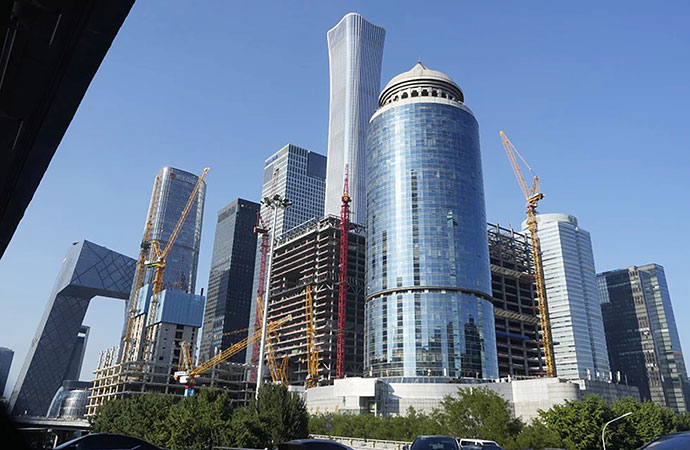Business

Construction cranes are seen near the central business district in Beijing, Aug. 8, 2024. Photo: AP/ UNB
China’s newly announced stimulus aims to boost liquidity, stimulate consumer spending, and revitalize the real-estate sector. Although it has already alleviated investor concerns about the government’s willingness to take bold action, it is just the first step toward realizing the Chinese economy's full growth potential.
The timing of China's new stimulus package is not coincidental. Arriving just before the 75th anniversary of the People's Republic, the announcement was well-received by equity investors, leading to a surge of more than 15% in the country's main stock indices.
The new package is reminiscent of the CN¥4 trillion ($568 billion) stimulus China introduced in late 2008 to shield its economy from the 2008-10 global financial crisis. That earlier package successfully made China one of the only major economies that did not suffer a severe recession, and in fact raised China's real GDP growth to 10% in 2010. It also provided a much-needed boost to global demand for other countries.
This time, the global impact of China's stimulus package will hinge on several key factors, including its size and reach, its success in enhancing domestic growth, and the strength of the country's economic ties to other countries.
The current stimulus package consists of three main components. First, it increases liquidity by reducing baseline interest rates by 20 basis points, mortgage rates by 50 basis points, and commercial banks' required reserve ratio by 50 basis points. Second, it seeks to revive the real-estate sector by lowering the minimum down payment on new home purchases. This is complemented by additional measures from local governments to boost demand for home purchases. Third, new fiscal measures, to be rolled out soon, will likely include cash transfers to low-income households and families with young children.
The recent surge in Chinese stock prices could reflect expectations of higher inflation, which would raise nominal profits, and anticipation of stronger corporate and economy-wide fundamentals. The two components have different implications for China's economy and the rest of the world.
At this point, the Chinese economy could benefit from a bit of inflation. In September 2023, I argued that China should have implemented a large-scale stimulus package to pull itself back from the brink of a debt-deflation spiral. In other words, the current stimulus should have come one year earlier. But better late than never.
Judging from financial-market reactions, the stimulus package is believed to have alleviated concerns about the government's willingness and ability to take bold steps to stimulate economic growth. Stock-market investors now seem more confident that China could turn its economy around and achieve stronger growth in the last quarter of this year and into 2025.
Both China and the world will need to wait and see if this optimism translates into increased consumer confidence, real investment by both private companies and state-owned firms, and a resurgence in foreign direct investment in the months and years ahead. The positive spillovers to the global economy would also be greater if driven by stronger Chinese economic fundamentals than just higher nominal prices.
Among developed economies, Australia and South Korea stand to benefit the most from an economic rebound in China, especially if it includes even a partial recovery in the real-estate sector, which would fuel demand for Australian iron ore and other raw materials. South Korea, home to key suppliers within China's regional and global value chains, would likely experience higher demand for its industrial exports.
If Chinese households become more willing to spend, countries that produce luxury products or attract Chinese tourists, such as France and Italy, could benefit significantly in the coming months, including around the next Chinese New Year in late January. By contrast, the United States is expected to experience more limited gains this time, owing to the many trade restrictions and technology export bans that it has imposed on China in recent years.
Japan was a major beneficiary of China's 2008 stimulus package, with many Japanese firms - like their South Korean counterparts - serving as key suppliers to Chinese companies. Japan is also a popular destination for Chinese tourists. While China's stimulus announcement has elicited little visible excitement on the Tokyo stock market, media reports suggest that concerns over the economic policies of Japan's new Prime Minister, Ishiba Shigeru, may have overshadowed any expected gains.
In the developing world, Southeast Asian countries such as Thailand and Malaysia, and major commodity producers like Chile and Argentina, could benefit from an increase in Chinese demand for commodities and industrial inputs.
The stimulus package is an important first step in reviving Chinese growth. For China to unlock its long-term growth potential, however, it must also implement more structural reforms. This will include further improvements in the business climate for all firms, especially non-state-owned and foreign firms. Such reforms would encourage entrepreneurs to invest and innovate more, and motivate households to spend more. Stronger Chinese growth will not only make its citizens better off, but also will generate greater positive spillovers for the rest of the world.
From Project Syndicate

























Leave a Comment
Recent Posts
Curtain rises on 6th National ...
The month-long '6th National Sculpture Exhibition 2024', organ ...
Thailand's sea nomads strive t ...
When Hook was a child, he started his days by jumping off the boat tha ...
Liliums grown in Bagerhat show surprising promise fo ..
Bangladesh’s three divisions brace for rain
Prioritise reconstruction of Gaza, West Bank, Lebano ..
In support of the vision set forth by the CA